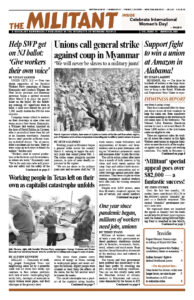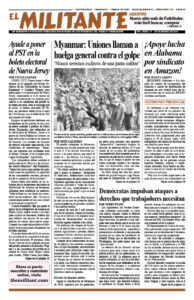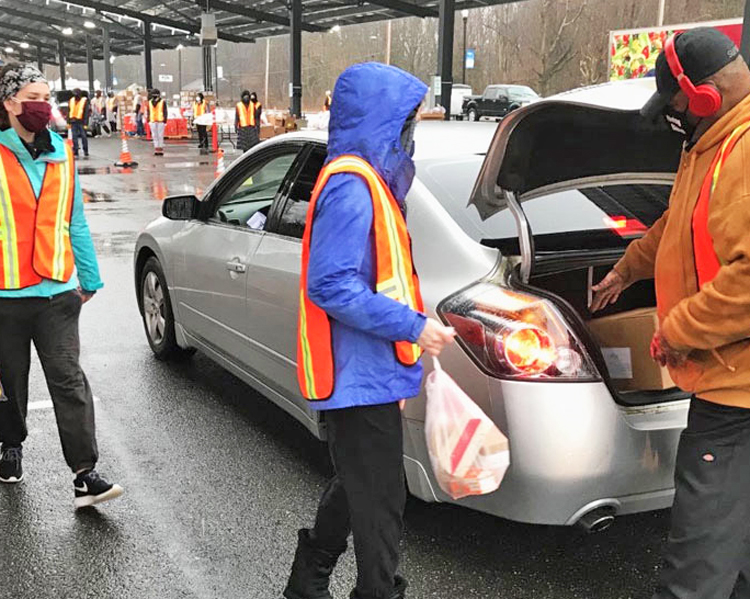Millions of workers remain out of work a year after government-ordered pandemic shutdowns slashed jobs in factories, restaurants, hotels, retail, schools and much more. Huge numbers found themselves driven out of the working class and isolated in their homes.
The bosses and their government have grabbed this opportunity to defend their profits by attacking our jobs, wages and working conditions. You can see this vividly today with the Marathon lockout of refinery workers in Minnesota and concessions demanded by the bosses at ATI steel in Pennsylvania.
While some lockdowns have been relaxed recently, the fight to reverse crippling joblessness remains vital for working people. It’s crucial to our ability to unite and to organize the battles needed to defend our working and living conditions, and strengthen our unions.
The “stimulus” bill being pushed by Democrats contains nothing to reverse vast unemployment, certainly not the kind of massive government-funded public works program that could provide millions of jobs at union scale to build and repair infrastructure, hospitals, schools, public transit and other things working people need today. Instead, it contains some one-time handouts and billions in subsidies for a wide variety of bosses and local governments.
There are over 9.5 million more workers out of a job today than a year ago. In 15 states the employment-to-population ratio — the percentage of working-age people who have a job — fell last year to the lowest levels ever recorded.
Unemployed workers face upheaval and uncertainty on their own, conditions that breed demoralization over time. Only at work can we join together, stand up to the bosses and exercise our power as a class. Through struggles on the job we discover what we are capable of doing and our self-confidence and class consciousness grows.
Last month Federal Reserve Board Chairman Jerome Powell admitted the real level of unemployment was double official government figures. For lowest-paid workers, the Federal Reserve estimates, unemployment is closer to 20%.
But even in the best of times, unemployment is integral to the workings of capitalist exploitation. It provides bosses with a ready-made reserve army of labor that they hire when it’s profitable and throw back out of work when it’s not. They aim to use divisions among those in and out of work as a lever to pit workers against each other, to boost profits by slashing wages and benefits, speeding up our work and disregarding our safety and health.
Workers finding ways to stand tall
Workers are looking for ways to stand up to these attacks. Some are organizing strikes and other fights. Voting for a union is underway at the Amazon fulfillment center in Bessemer, Alabama, a fight being watched closely by workers elsewhere and that merits solidarity from all workers and farmers and our unions.
“Central to strengthening struggles workers are involved in today is the need to get more of us back to work,” Joe Swanson, retired rail worker and Socialist Workers Party candidate for City Council in Lincoln, Nebraska, told the Militant. “The SWP campaign calls on unions to mobilize workers to fight for a shorter workweek with no cut in pay, to share the available work around.”
The government says that there is no problem with inflation today, and maybe that’s true for the things the boss class loads up on. But working people are being hit by rising prices for our basic necessities. Food inflation was up by 3.9% in 2020, its highest increase in nine years. Meat prices shot up 5.5%.
“Workers need to fight for cost-of-living clauses in every union contract that force the bosses to raise our wages and retirement pay every time prices go up, regardless of the effect on their profits,” Swanson said. “Only by fighting for our class interests against the class that exploits us can workers defend ourselves.”
Long before the pandemic, millions of workers faced an uphill struggle to cover monthly expenses for rent, health insurance and utilities. Now three times more people are behind in their rent, the Census Bureau reports. The government claims evictions are temporarily on hold, but some workers who rent are still being thrown out on the street and others are on the hook for spiraling rent arrears, adding to the burden of all kinds of debts that weigh on working people.
For decades profit rates of the ruling capitalist families have tended to decline. As a consequence they have shied away from investing in new factories and capacity-expanding equipment that would provide jobs. Instead, they’ve engaged in an ongoing orgy of speculative investment in bonds, stocks, Bitcoin, derivatives and all kinds of paper. A stark example of this frenzy was the recent war between manipulators of GameStop stock prices and competing hedge-fund tycoons. At some point this bubble will burst with devastating consequences for working people.
“If efforts to control the pandemic make headway and the capitalist economy improves,” Swanson said, “the job openings created will give our class more confidence to fight.
“Every question we face today has to be answered from the standpoint of the interests of working people,” he said. “Democrats and Republicans do everything possible to hide that reality, by claiming to speak for ‘all Americans.’ But that’s a lie. Workers need to build our own party, a labor party.”


